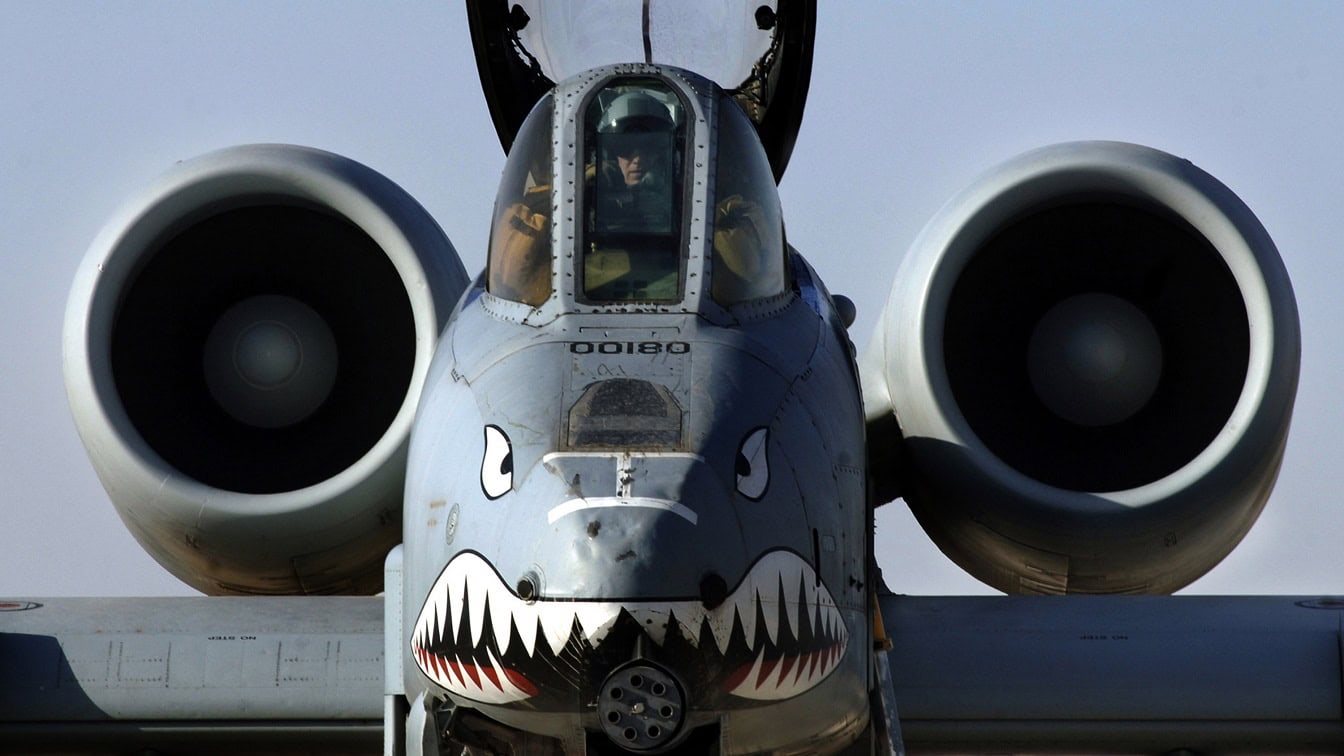The Fairchild A-10 Thunderbolt II is known to those who fly it as the “Warthog.” Often described as a flying tank, it was tailor-made for close air support and to take out enemy armored vehicles. It employs the unique GAU-8/A Avenger 30mm (1.18-inch) cannon.
It was designed to offer excellent maneuverability at low airspeeds and altitude while maintaining a highly accurate weapons-delivery platform. The aircraft can loiter near battle areas for extended periods of time, and it is capable of austere landings and operating under 1,000-foot ceilings (303.3 meters) with 1.5-mile (2.4 kilometers) visibility. The Warthog’s wide combat radius and short takeoff and landing capability permit operations in and out of locations near the front lines. In addition, with night vision goggles, A-10C pilots can conduct their missions during near-complete darkness.
A-10 Warthog: Come Inside the Cockpit
The first operational A-10s were delivered to Davis-Monthan Air Force Base (AFB), Arizona in March 1976. The aircraft was first deployed during Operation Urgent Fury, the 1983 American invasion of Grenada, and provided air cover for the United States Marine Corps, but did not fire their weapons.
In fact, it wasn’t until the Gulf War in 1991 that the aircraft took part in combat operations, when A-10s successfully shot down two Iraqi helicopters with the GAU-8, and took part in numerous sorties against Iraqi Republican Guard units. While several A-10s were shot down by surface-to-air missiles, nearly a dozen were hit by anti-air artillery rounds and remained airworthy. In fact, the Warthog performed so well in the conflict that the Air Force abandoned an idea to replace the A-10s with a close air support version of the F-16 Fighting Falcon.
A Hearty Warbird
The design of the A-10 took into account the requirement of battlefield survivability and anti-armor firepower. As a result, the Warthog can take damage that would see other planes crashing to the ground, and it is able to remain airworthy even if either half of the twin-finned tail were to be shot away. To aid in maintenance, all parts of the left and right tails were designed and developed to be interchangeable.
The twin engines are mounted in widely spaced pods above the rear fuselage in order to minimize the effects of ground fire, while the vertical fins and wings serve to shield the exhaust from heat-seeking missiles.
The aircraft’s tough airframe included a titanium armored “bathtub” for the pilot and cannon ammunition, while other features were included to improve survivability, either through their resistance to battle damage or redundancy. The A-10’s designers also placed an emphasis on ease of maintenance, since it was anticipated that in wartime, the Thunderbolt II would be required to fly a large number of sorties in rapid succession from forward operating locations.
Heavily Armed
In its initial form, the A-10 was equipped with avionics including a Pave Penny laser designator pod on a pylon on the right of the forward fuselage, while self-protection equipment on the A-10 included jamming pods and a chaff and flare dispenser.
The A-10 is most famously – even infamously – known for its Avenger cannon, which can fire up to 3,900 rounds per minute. The 30mm shell has twice the range, half the time to target, and three times the mass of projectiles fired by guns mounted in comparable close air support aircraft. The GAU-8/A has about the same muzzle velocity as the M61 Vulcan cannon, but as it uses heavier ammunition, the Avenger has superior ballistics.
The gun’s recoil forces could actually push the entire plane off target during firing, which is why the cannon is mounted laterally off-center, slightly to the port side of the fuselage centerline. That arrangement accurately centers the recoil forces and prevents changes in the A-10’s pitch or yaw when firing the Avenger. The unique configuration also required the front landing gear to be mounted slightly off-center on the starboard side of the nose.
The development of the weapon dates back to the early 1970s when the United States Air Force issued a request for proposal (RFP) for a 30mm rapid-fire cannon that could be used with its A-X Close Air Support aircraft. General Electric developed a prototype, designated the GAU-8. In addition to the weapon, the government contract also called for the development of four types of ammunition that would be used with the cannon and these included Armor Piercing Incendiary, High Explosive Incendiary, Semi-Armor Piercing High Explosive, and Target Practice.
Though the A-10 is best associated with the GAU-8/A, its primary weapon was always intended to be the AGM-65 Maverick air-to-surface missile, with TV or laser guidance.
In March 2022, the Air Force announced that it had tested an A-10C Thunderbolt II loaded with GBU-39 Small-Diameter Bombs near Eglin Air Force Base (AFB), Florida. This integration of the GBU-39 on the A-10 is one of the major upgrades that were announced in 2019 as part of the A-10 Common Fleet Initiative.
FROM 19FortyFive: The War in Ukraine Is About to Explode
FROM 19FortyFive: Does Putin Have Cancer?
A Senior Editor for 19FortyFive, Peter Suciu is a Michigan-based writer. He has contributed to more than four dozen magazines, newspapers, and websites with over 3,000 published pieces over a twenty-year career in journalism. He regularly writes about military hardware, firearms history, cybersecurity, and international affairs. Peter is also a Contributing Writer for Forbes. You can follow him on Twitter: @PeterSuciu.

